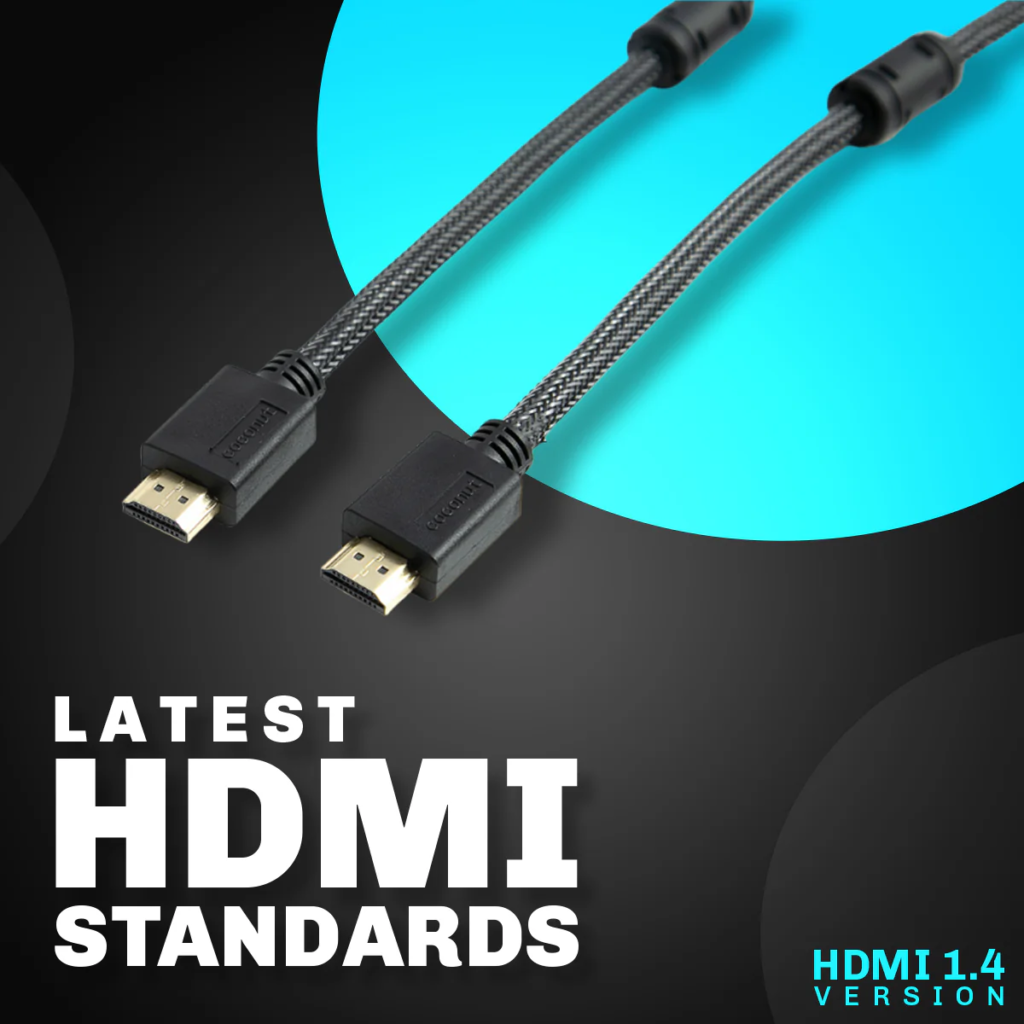
hdmi cable
HDMI cables are an essential component for connecting modern digital devices, whether you’re setting up a home theater, improving your gaming setup, or just trying to enhance your work-from-home station. Despite being common, HDMI cables still generate a lot of questions about how they work, what types are available, and how to choose the best one for your needs. This comprehensive guide dives into every aspect of HDMI cables, giving you everything you need to know to make informed decisions.
What is an HDMI Cable?

HDMI (High-Definition Multimedia Interface) cables are specially designed connectors that transmit high-quality video and audio signals between devices. Introduced as a single-cable solution, HDMI cables quickly became the go-to standard for high-definition transmissions, replacing older analog and digital interfaces like VGA and DVI. These cables have made it possible to enjoy crystal-clear picture and sound, whether you’re watching TV, playing games, or connecting a laptop to a projector.
HDMI cables operate by carrying uncompressed signals, making them ideal for high-definition and ultra-high-definition resolutions. With an HDMI connection, data transfer is quick, reliable, and supports various video formats, including Full HD (1080p), 4K, and even 8K. Additionally, HDMI cables offer support for a wide range of audio formats, making them perfect for creating an immersive experience.
In today’s digital age, HDMI cables are compatible with most modern electronic devices, from TVs and projectors to gaming consoles and Blu-ray players. The convenience of a single-cable solution has made HDMI a universal standard for connecting multimedia devices, eliminating the need for multiple cords or complex setup processes.
History of HDMI Cables
The history of HDMI cables traces back to the early 2000s when digital video was rapidly evolving. Prior to HDMI, different cables were needed for video and audio, often resulting in a clutter of connections. HDMI was developed in 2002 by a group of tech companies, including Sony, Toshiba, and Panasonic, to standardize audio and video transmission in a single cable.
Initially, HDMI was limited to transmitting 1080p video and a few audio formats, but as technology advanced, so did HDMI’s capabilities. New versions have since been introduced, with HDMI 2.1 being the latest. This progression has allowed HDMI to keep up with innovations in home entertainment, supporting resolutions like 4K and 8K, higher refresh rates, and enhanced audio quality. Each version brought new features that made HDMI increasingly versatile.
The impact of HDMI on audio-video technology has been significant. It made it possible for consumers to connect high-definition devices without needing specialized knowledge. With its backward compatibility, HDMI continues to support older devices while also embracing the latest technology, ensuring users always have a convenient connection solution.
How HDMI Cables Work
HDMI cables work by transmitting digital data in the form of electrical signals from one device to another. The cable is designed with multiple copper wires bundled together, each assigned to carry specific types of data—whether that’s video, audio, or control information. These signals are sent as digital “packets” of data, which maintain the quality of the original signal even over longer distances.
One of the defining features of HDMI is its ability to carry both video and audio signals without compressing them. This preserves the original quality of the content, making HDMI ideal for high-resolution displays and high-fidelity audio systems. HDMI cables are also designed to be “intelligent,” meaning they can communicate with connected devices to automatically adjust settings, such as resolution and aspect ratio, to deliver the best possible experience.
Another feature of HDMI is HDCP (High-bandwidth Digital Content Protection), which prevents unauthorized copying of digital content. HDCP compatibility is essential for playing content from Blu-ray discs or streaming platforms, ensuring that protected content can only be displayed on authorized devices.
Different Types of HDMI Cables
While all HDMI cables may look similar, there are several types designed for different uses. The three main types are Standard HDMI, Mini HDMI, and Micro HDMI. Each type has a distinct physical size and is suited to specific devices.
- Standard HDMI: This is the most common type, used for TVs, projectors, gaming consoles, and computers. It is the full-sized version of HDMI and provides robust support for video and audio signals, making it ideal for home theater setups.
- Mini HDMI: Found on devices like camcorders, tablets, and some smaller laptops, Mini HDMI is a smaller version of the standard HDMI connector. It offers the same functionality in a more compact form, allowing portable devices to connect to larger displays.
- Micro HDMI: Smaller than Mini HDMI, this version is often used for smartphones, tablets, and ultra-compact cameras. Micro HDMI is convenient for mobile devices, allowing users to connect them to larger displays without sacrificing quality.
Each type of HDMI connector has its own place in the tech world, catering to different device types and usage scenarios. Knowing which HDMI type your devices require ensures compatibility and helps you avoid any setup issues.
HDMI Cable Versions Explained
HDMI cables come in various versions, each one supporting a unique set of features. The most common versions include HDMI 1.4, HDMI 2.0, and HDMI 2.1.
- HDMI 1.4: Introduced 3D capabilities and supported 4K at 30Hz, making it a significant step up from previous versions. HDMI 1.4 is ideal for basic HD setups and standard gaming consoles.
- HDMI 2.0: Brought substantial improvements, such as support for 4K at 60Hz, allowing for smoother video playback. HDMI 2.0 also supports higher color depths and better audio channels, making it suitable for advanced home theater systems.
- HDMI 2.1: The latest HDMI version, supporting 8K resolution at 60Hz and 4K at 120Hz. It’s designed for the most cutting-edge setups, offering high refresh rates, dynamic HDR, and the bandwidth to handle demanding content, such as high-frame-rate gaming and professional video editing.
Choosing the right HDMI version depends on your needs. While HDMI 1.4 is sufficient for standard HD viewing, HDMI 2.1 is essential for enthusiasts looking for the best possible picture and sound quality.
HDMI Connectors and Their Types
HDMI connectors come in five main types, each with its own specific use cases and compatibility requirements.
- Type A: The standard HDMI connector, commonly used in TVs, computers, and projectors.
- Type B: A rare connector designed for dual-link HDMI, but it’s largely unused in consumer electronics.
- Type C: Also known as Mini HDMI, it’s used in smaller devices like cameras and tablets.
- Type D: Known as Micro HDMI, used in smartphones and compact devices for space efficiency.
- Type E: This is an automotive HDMI connector, designed for in-car entertainment systems and navigation units.
Each type ensures that HDMI can be applied across a range of devices, from home entertainment to portable electronics. Understanding these types can help you select the right connector for your setup.
Comparing HDMI Cables to Other Cables
When it comes to digital connections, HDMI is often compared with VGA, DVI, and DisplayPort. Here’s a breakdown of how HDMI stacks up:
- VGA: VGA is an analog connector, primarily used for computer monitors. HDMI offers a far superior quality with support for both video and audio, which VGA lacks.
- DVI: DVI is a digital connector similar to HDMI but supports only video. HDMI’s inclusion of audio makes it more convenient and efficient for home setups.
- DisplayPort: DisplayPort is similar to HDMI in quality and versatility but is more commonly found in professional computer setups. HDMI is more widespread in consumer electronics.
While each cable type has its strengths, HDMI remains the most popular for consumer use, thanks to its versatility and ease of use.






